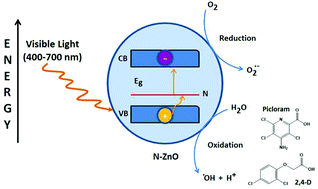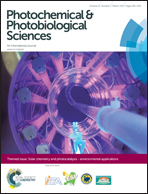Synthesis of nitrogen-doped ZnO by sol–gel method: characterization and its application on visible photocatalytic degradation of 2,4-D and picloram herbicides†
Abstract
In this work, nitrogen-doped ZnO material was synthesized by the sol–gel method using zinc acetate as the precursor and urea as the nitrogen source (15, 20, 25 and 30% wt.). For comparative purposes, bare ZnO was also prepared. The influence of N doping on structural, morphological, optical and photocatalytic properties was investigated. The synthesized catalysts were characterized by XRD, SEM-EDS, diffuse reflectance UV-Vis spectroscopy, BET and XPS analysis. The photocatalytic activity of N-doped ZnO catalysts was evaluated during the degradation of a mixture of herbicides (2,4-D and picloram) under visible radiation ≥400 nm. The photo-absorption wavelength range of the N-doped ZnO samples was shifted to longer wavelength compared to those of the unmodified ZnO. Among different amounts of dopant agent, the 30% N-doped ZnO material showed higher visible-light activity compared with pure ZnO. Several degradation by-products were identified by using HPLC and ESI-MS/MS. The enhancement of visible photocatalytic activity of the N-doped ZnO semiconductor could be mainly due to their capability in reducing the electron–hole pair recombination.

- This article is part of the themed collection: Solar Chemistry and Photocatalysis - environmental applications

 Please wait while we load your content...
Please wait while we load your content...